 Sai Nrityotsava
- 16 September 23,
2010 On the 1st
of September, no seats were available in Seva Sadan, Bangalore, for those
who came after the hour for the monthly Sai Nrithyotsava -16. The extended
monsoon rains did not deter the connoisseurs of dance from attending this
festival. This seems to be good proof of its popularity for wholesome classical
entertainment. The addition of the Natya series between the Nrithya segments
gave a different dimension.
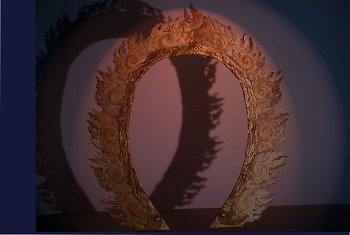 Tanka
arch
Tanka
arch
|
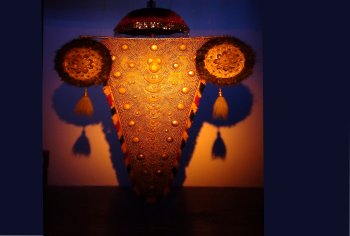 Aane netti
patti
Aane netti
patti
|
In the past four
festivals, one saw stage backdrops that were unique. Starting with a Prabavali
of fire inspired by the Tanka paintings of Tibet in one festival, a wall
of Jhali and four ornate pointed arches of Jaipur Mahals in another, a
gigantic replica of the “Aane netti patti” of Kerala in the previous festival,
this utsava saw a replica of a silver temple door complete with pillars,
beams and brackets embellished with silver lotus, from Karnataka. Through
these backdrops, Nishant Aravindakshan and Shakthi R Shetty of Articulate
gave a distinct touch to stage craft. These visual arts were no distraction
in appreciating the dances performed in front of them. In fact, it complemented
the performance.As a tribute
to two Indian classical dance forms Bharatanatyam and Odissi, the dancers
held a mirror of religious and philosophical blend reflecting the similarities
and distinctions between the two dance genres. S Raghunandan in Bharatanatyam
and Manasi Pandya in Odissi, presented Naman based on Pushpanjali
and mangalacharan, invoking divine energy for embarking on the evening’s
dance journey. ‘Nrithyabhinayam’ saw religious episodes with contrasting
representations of Goddess Durga in Odissi and Mahishasura in Bharatanatyam
while ‘Nrithyarpanam’ showcased elements from Tillana and ‘Mokshya.’ In
trying to balance between tradition and modernity, both the artistes took
away the prescribed beauty. Being physically big dancers, they would also
do well to pay attention to work towards a trim physique.
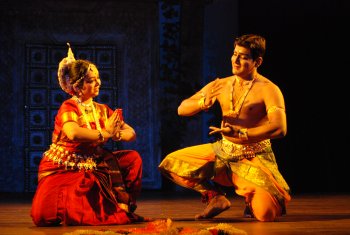 S Raghunandan
and Manasi Pandya
S Raghunandan
and Manasi Pandya
|
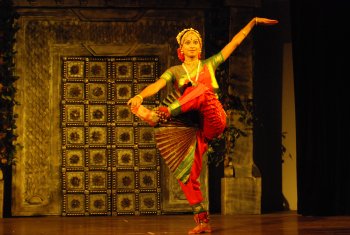 Aparajita
Sharma
Aparajita
Sharma
|
In the second
segment of the Nrityotsava, Aparajita Sharma lined up a Kauthuvam, a bhajan
and a Tillana, which she performed with neat lines and befitting expressions.
The Natesha Kauthuvam set to Nattai raga and adi tala, was embellished
with karanas that ended with sculpture like momentary freezes. The bhajan
in Sindhu Bhairavi-adi tala was justified with subtle expressions of a
Sringara Nayika in Meera through her poetry “Jo tum todo piya.” Meera’s
determination to hold on to the lotus feet of Krishna even if he desired
to forsake her was effectively portrayed. The artist’s dedication to dance
and desire for perfection in the nritta was amply seen in Tillana in Desh
raga set to adi tala.
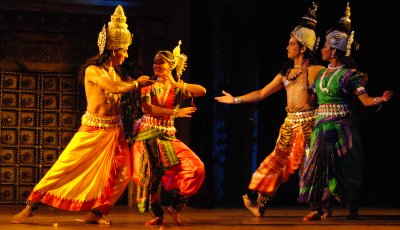 Bilva
Bilva
|
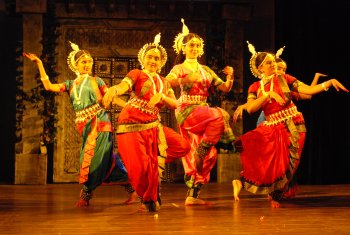 Bilva
Bilva
|
Articulate and
Sai Arts International jointly presented their Natya Series-3 in motifs
of Odissi. In this series of narrating the puranic stories behind
medicinal plants and trees that are native to India, N Kavyashree choreographed
this dance drama on the story of the origin of the BILVA tree. Goddess
Lakshmi found two lotus flowers less during her Shivarchana. Considering
getting up to get some more, an interruption to such a holy ritual, and
remembering how Hari compared her full breasts to the freshly bloomed Lotus,
Lakshmi cuts off one of them and offers as a flower to Shiva Linga. While
she prepared to cut off the second breast, Shiva appeared and stopped her
from offering, for he was immensely pleased by her devotion unto Him.
Shiva deliberated on the fact that Lakshmi being Mother Earth herself,
her breasts were the source of nourishment and long life of all living
beings. Not wasting the act of fath, Shiva planted it on the earth and
from there arose the Bilva tree. Shiva declared that the tree was Goddess
Lakshmi herself and the trifoliate leaves shall ever be the one that pleases
him the most among all the offerings. The interesting twist in the story
was that Shiva himself narrates this to Parvathy, when she questioned him
on why it was only the bilva patra that was not crushed under his dancing
feet while all other flowers were. Graceful Shweta Venkatesh as Lakshmi,
handsome Nishant Aravindakshan as Hari, energetic Somashekar Chudanath
as Shiva enacted their roles very effectively. Pushya, Sindhu, Yashaswini
and Suchita as the sakhis of Lakshmi danced very well. Apart from
enacting the role of Parvathy, Kavyashree’s effort in directing Bharatanatyam
dancers in Odissi style was appreciable. What really stole the show was
an invocatory number to Goddess Saraswati by Nisha K, who was grace personified.Bharatanatyam
dancer Meghana Venkat performed an invocatory number, a keerthana and a
javali before she concluded with an Ashtapadi. Set to Trishra Jumpa Tala
and Naatai raga, obeisance was offered to Ganesha, Subramanya, Shiva,
Shivakami and Chandikeshwara in the Panchamurthanjali. The Vasantha
raga and Khanda Atta tala based “Natanam Aadinaar” was followed by a Kannada
number “Sako ninna sneha sarasa vinyatako.” The anger of a Khandita Nayika
towards Krishna was expressed through Jayadeva’s “Chandana charchita.”
Abhinaya was Meghana Venkat’s forte which she exhibited to the appreciative
audience.
 Meghana
Venkat
Meghana
Venkat
|
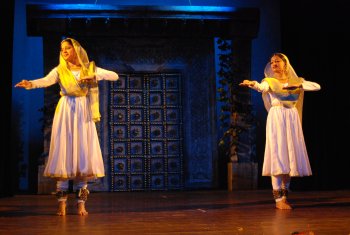 Disciples
of Chitra Venugopal
Disciples
of Chitra Venugopal
|
Kathak Guru Chitra
(Rao) Venugopal presented her disciples, Devika Vishnu, Chaitra P
Y, Jhalak Srivastava, Prabhati Kisku, Surabhi Swaminath, Sumana S and Suraiya
Parveen in the concluding segment of the festival. Two of the repertoire
was choreographed by her and two were that of Guru Dr. Maya Rao. Beginning
with an invocation to Ganesha through a poetry penned by Ibrahim Adil Sha
of Bijapur and composed in Raag Malhar set to ek taal, the presentation
proceeded with a composition of Maharaj Bindadin describing the playfulness
of Radha and Krishna on the makeshift swing during the festival heralding
the arrival of the Monsoon. Praband, composed by Ustd Altaf Hussein Khan
in Kedar raag and teen taal was performed before they signed off with a
Tarana in Raag Durga and teen taal.One of the
missions of SAI Nrityotsava is to provide opportunities for young artistes
for a dance experience and this was utilized by the students of Kala Bharati,
a cultural wing of the Bangalore centre of Bharatiya Vidya Bhavan. |

